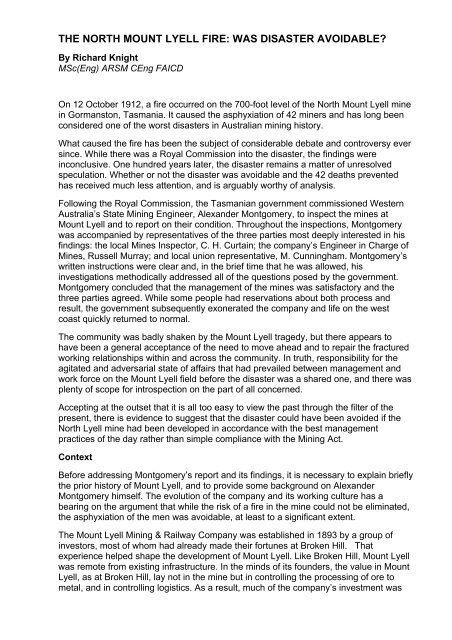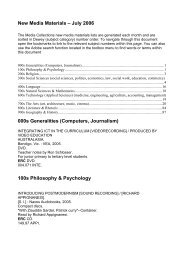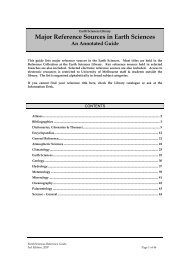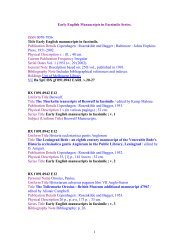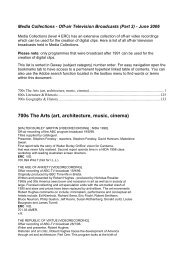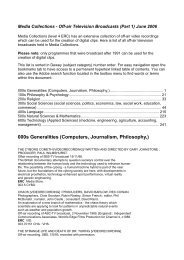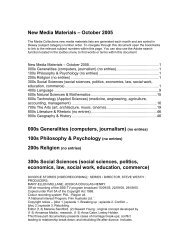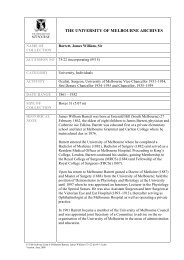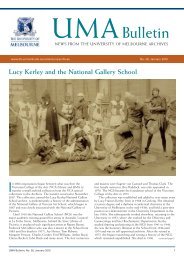The North Mount Lyell fire: Was disaster avoidable?
The North Mount Lyell fire: Was disaster avoidable?
The North Mount Lyell fire: Was disaster avoidable?
Create successful ePaper yourself
Turn your PDF publications into a flip-book with our unique Google optimized e-Paper software.
THE NORTH MOUNT LYELL FIRE: WAS DISASTER AVOIDABLE?<br />
By Richard Knight<br />
MSc(Eng) ARSM CEng FAICD<br />
On 12 October 1912, a <strong>fire</strong> occurred on the 700-foot level of the <strong>North</strong> <strong>Mount</strong> <strong>Lyell</strong> mine<br />
in Gormanston, Tasmania. It caused the asphyxiation of 42 miners and has long been<br />
considered one of the worst <strong>disaster</strong>s in Australian mining history.<br />
What caused the <strong>fire</strong> has been the subject of considerable debate and controversy ever<br />
since. While there was a Royal Commission into the <strong>disaster</strong>, the findings were<br />
inconclusive. One hundred years later, the <strong>disaster</strong> remains a matter of unresolved<br />
speculation. Whether or not the <strong>disaster</strong> was <strong>avoidable</strong> and the 42 deaths prevented<br />
has received much less attention, and is arguably worthy of analysis.<br />
Following the Royal Commission, the Tasmanian government commissioned Western<br />
Australia’s State Mining Engineer, Alexander Montgomery, to inspect the mines at<br />
<strong>Mount</strong> <strong>Lyell</strong> and to report on their condition. Throughout the inspections, Montgomery<br />
was accompanied by representatives of the three parties most deeply interested in his<br />
findings: the local Mines Inspector, C. H. Curtain; the company’s Engineer in Charge of<br />
Mines, Russell Murray; and local union representative, M. Cunningham. Montgomery’s<br />
written instructions were clear and, in the brief time that he was allowed, his<br />
investigations methodically addressed all of the questions posed by the government.<br />
Montgomery concluded that the management of the mines was satisfactory and the<br />
three parties agreed. While some people had reservations about both process and<br />
result, the government subsequently exonerated the company and life on the west<br />
coast quickly returned to normal.<br />
<strong>The</strong> community was badly shaken by the <strong>Mount</strong> <strong>Lyell</strong> tragedy, but there appears to<br />
have been a general acceptance of the need to move ahead and to repair the fractured<br />
working relationships within and across the community. In truth, responsibility for the<br />
agitated and adversarial state of affairs that had prevailed between management and<br />
work force on the <strong>Mount</strong> <strong>Lyell</strong> field before the <strong>disaster</strong> was a shared one, and there was<br />
plenty of scope for introspection on the part of all concerned.<br />
Accepting at the outset that it is all too easy to view the past through the filter of the<br />
present, there is evidence to suggest that the <strong>disaster</strong> could have been avoided if the<br />
<strong>North</strong> <strong>Lyell</strong> mine had been developed in accordance with the best management<br />
practices of the day rather than simple compliance with the Mining Act.<br />
Context<br />
Before addressing Montgomery’s report and its findings, it is necessary to explain briefly<br />
the prior history of <strong>Mount</strong> <strong>Lyell</strong>, and to provide some background on Alexander<br />
Montgomery himself. <strong>The</strong> evolution of the company and its working culture has a<br />
bearing on the argument that while the risk of a <strong>fire</strong> in the mine could not be eliminated,<br />
the asphyxiation of the men was <strong>avoidable</strong>, at least to a significant extent.<br />
<strong>The</strong> <strong>Mount</strong> <strong>Lyell</strong> Mining & Railway Company was established in 1893 by a group of<br />
investors, most of whom had already made their fortunes at Broken Hill. That<br />
experience helped shape the development of <strong>Mount</strong> <strong>Lyell</strong>. Like Broken Hill, <strong>Mount</strong> <strong>Lyell</strong><br />
was remote from existing infrastructure. In the minds of its founders, the value in <strong>Mount</strong><br />
<strong>Lyell</strong>, as at Broken Hill, lay not in the mine but in controlling the processing of ore to<br />
metal, and in controlling logistics. As a result, much of the company’s investment was
put into a smelter and a railway. Capital was scarce, and investment in the mines was<br />
held to a minimum.<br />
In light of the limited availability and high-delivered cost of coke, the company’s<br />
metallurgist and future General Manager, Robert Sticht, chose to adopt pyritic smelting,<br />
using the sulphides in the ore to fuel the process. Pyritic smelting proved to be a great<br />
success at <strong>Mount</strong> <strong>Lyell</strong>, both technically and economically, and Sticht was justly lauded<br />
for his achievement. In the years that followed, the <strong>Mount</strong> <strong>Lyell</strong> Board deferred to<br />
Sticht’s expertise, and he was left to run the business more or less as he saw fit.<br />
<strong>The</strong> copper content of the <strong>Mount</strong> <strong>Lyell</strong> ore body was soon to prove disappointing, falling<br />
steadily year on year and triggering a desperate scramble for smelter feed. <strong>The</strong> second<br />
largest company on the field, <strong>The</strong> <strong>North</strong> <strong>Mount</strong> <strong>Lyell</strong> Copper Company, extravagantly<br />
elected to build a second smelter and railway, cutting off the supply of high-grade<br />
siliceous <strong>North</strong> <strong>Lyell</strong> ore to the <strong>Mount</strong> <strong>Lyell</strong> smelter. Consequently, instead of being, as<br />
Sticht had envisaged, self-sufficient and a buyer of custom ore on its own terms from<br />
the smaller mines, <strong>Mount</strong> <strong>Lyell</strong> became hostage to the <strong>North</strong> <strong>Lyell</strong> company, and its<br />
smelter began to look like a stranded asset. Both companies got into financial difficulties<br />
but, in the end, common sense prevailed. A merger was consummated in August 1903.<br />
<strong>Mount</strong> <strong>Lyell</strong> Mining & Railway Company emerged as the survivor, largely through<br />
recognition of its superior technical expertise and management, although <strong>North</strong> <strong>Lyell</strong><br />
was soon to prove the better mine. <strong>The</strong> merged entity powered ahead.<br />
Sticht, through the agency of his Engineer in Charge of Mines, R M Murray, quickly put<br />
his stamp on the <strong>North</strong> <strong>Lyell</strong> mine, instilling a culture of strict working discipline where<br />
considerable laxity had previously prevailed. In an environment of growing trade union<br />
militancy, Sticht’s authoritarian style was not widely appreciated and the relationship<br />
between management and workforce slowly became more adversarial, with<br />
consequences for the future. Sticht was a benign autocrat, who took a paternalist<br />
approach towards employees. Although not unduly arbitrary in his dealings with the<br />
work force at large, he did little to ameliorate the harsh living and working conditions on<br />
the west coast. In his social attitudes, he was very much a creature of his class and<br />
time, lacking both empathy and the common touch.<br />
Russell Murray came to Queenstown in 1900 as a draughtsman and assistant surveyor.<br />
Sticht was his mentor. Murray, barely 29, was appointed Engineer in Charge of Mines in<br />
1906. Murray was a talented manager and a natural leader, but his first-hand<br />
experience and knowledge of mining was brief and limited to <strong>Mount</strong> <strong>Lyell</strong>. <strong>The</strong><br />
expectations and attitudes of management and labour were poles apart, differences<br />
being further aggravated by the poor living conditions and the perception, promoted by<br />
industrial agitators, that the mines were unsafe and that the accident rate was<br />
abnormally high. Serious accidents and fatalities were distressingly commonplace at<br />
work, and there was little or no compensation for the affected families, but the statistics<br />
for <strong>Mount</strong> <strong>Lyell</strong>, appalling to modern eyes, were in fact no different from those of other<br />
major mining fields in Australia.<br />
Alexander Montgomery<br />
Montgomery was a New Zealander, graduating MA from Otago University in 1882.<br />
After several years with the Public Works Department, he became Director of the<br />
Thames School of Mines, Hauraki Gold Fields, remaining there until he was appointed<br />
Inspector of Mines and Geological Surveyor for Tasmania in 1889. From Tasmania,<br />
Montgomery moved back to New Zealand in 1897 to manage a gold mining company<br />
before returning once again to Australia in 1902 as State Mining Engineer for WA, in<br />
which position he remained until 1930.
Montgomery was well credentialed and well regarded; and well-known in Tasmania.<br />
He was handpicked for the assignment, and his report deserves careful examination,<br />
not only for what it says but also for what it tries to achieve; harmony among the various<br />
unhappy factions on the west coast.<br />
Fire Risk<br />
Simply put, risk must be assessed in two ways; probability and consequence. Both<br />
should be minimised to the extent practicable through management action, and sensible<br />
procedures put in place to ameliorate any residual risk. <strong>The</strong>re was little structured<br />
thought given to hazard management in 1912, and it would be unfair to judge<br />
management practices then by the standards of today, however let us consider what<br />
was known and understood at the time.<br />
<strong>North</strong> <strong>Lyell</strong> was a relatively wet mine, and the <strong>fire</strong> risk was not high. It resided principally<br />
with the electrical equipment in the mine, in effect pump motors and the reticulation of<br />
electric power to those motors. Under these circumstances, it might be argued that the<br />
probability of a <strong>fire</strong> was very low; but, as events were to show, the consequences were<br />
disastrous.<br />
<strong>The</strong> Disaster<br />
On 12 October 1912, there were 170 men underground. Men were working in stopes<br />
and headings above and below the seat of the <strong>fire</strong> in the 700 foot level pump station,<br />
but much of the activity was in the lower levels of the mine where, following the<br />
discovery of the new development ore body in 1905, the pace of development was<br />
frenetic. By 1912, the workings on the lower levels were extensive. In the absence of<br />
any system, warning the men of the <strong>fire</strong> after it had been detected proved difficult and<br />
hazardous for the mine supervisors and volunteers involved, for the smoke and gases<br />
from the <strong>fire</strong> spread rapidly throughout the mine, assisted by the piston effect of the<br />
cages moving in the main shaft evacuating those men who had been alerted to the<br />
danger.<br />
<strong>The</strong> main shaft was the principal means of entry and egress. 74 men escaped by way of<br />
the main shaft on the day of the <strong>fire</strong>, and a further four were rescued through this shaft<br />
from the 500 foot level on the following day. <strong>The</strong> second means of egress was through<br />
the engine winze, a small shaft that extended from the 300 foot level to the bottom of<br />
the mine. At the time of the <strong>fire</strong>, the winze was closed; the timber sets in one section<br />
having been crushed by squeezing ground. It took three shifts to re-establish a ladder<br />
way through the crushed zone. A further 50 men were rescued by means of these<br />
ladders.<br />
Despite the best efforts of the rescuers who flocked to the mine from all quarters, 42<br />
men working in the deeper levels perished through asphyxiation as the smoke and<br />
gases descended the mine. When all hope of rescuing these men alive had been<br />
abandoned, the <strong>fire</strong> was extinguished by allowing the mine to flood. It was some months<br />
before the lower workings were dewatered and all the bodies recovered.<br />
<strong>The</strong> Montgomery Report<br />
Before commenting on Montgomery’s findings, it must be stated that the company was<br />
working in full compliance with the Mining Act and Regulations, as they stood at the<br />
time. Beyond the Act, the safety of employees depended very much on their own<br />
common sense and experience, and the diligence of their supervisors. <strong>Mount</strong> <strong>Lyell</strong><br />
seems to have been well served by the latter but there was no formal training for<br />
miners, nor supervisors. New men were assigned to work with old hands, and
consequently learned all their habits; good and bad, safe and unsafe. Such was the<br />
practice of the times.<br />
Montgomery was asked to make a thorough examination of both mines (<strong>Mount</strong> <strong>Lyell</strong> as<br />
well as <strong>North</strong> <strong>Lyell</strong>) and to respond to four general allegations and to 7 more specific<br />
questions. His report was almost universally favourable to the company, and there was<br />
no dissent with respect to his findings from any of those who accompanied his<br />
inspections. In some instances he offered mild criticism of current practice, then<br />
rationalised the practice by stating that it represented the best that could practically be<br />
done. That may have been true with respect to contemporary Australian practice, but<br />
mining methods were evolving fast, especially in the US, and there is little evidence to<br />
suggest that local management was keeping abreast of these developments.<br />
<strong>The</strong> first allegation maintained that management had been negligent with regard to<br />
keeping the mine in a safe condition. This amounted to disagreement over the mining<br />
methods being used, but Montgomery’s inspections found the mines to be generally in<br />
good physical condition. <strong>The</strong> second allegation was that the timber in the main shaft<br />
was likely to collapse at any time. This was clearly without foundation, the fact being<br />
revealed by a detailed inspection undertaken by riding the cage from the top to the<br />
bottom of the shaft.<br />
<strong>The</strong> third allegation was that danger existed because there was only one functioning<br />
exit from the <strong>North</strong> <strong>Lyell</strong> mine. <strong>The</strong> engine winze was blocked at the time of the <strong>fire</strong> and<br />
it took the work of three shifts to restore the winze as an exit. As mentioned above,<br />
50men subsequently escaped through this means, and Montgomery used this<br />
somewhat fortuitous event, combined with the fact that the Mining Act did not require a<br />
second exit from metal mines, to dismiss this allegation. This was not a supportable<br />
position even in 1912, although it failed to excite any official comment. <strong>The</strong> engine<br />
winze should have been maintained in a proper state of repair. Had it been open, some<br />
lives may have been saved through more rapid communication of the evacuation order.<br />
<strong>The</strong> fourth allegation was that a number of stopes in both mines were not safe, and that<br />
there was a danger of a general collapse. This overstated the case; there was no risk of<br />
a general collapse on the evidence presented, but unpredictable ground conditions did<br />
exist in a number of places that required the greatest skill and caution to manage safely.<br />
<strong>The</strong> solution to these local hazards was to take a more precautionary approach to<br />
stoping, something that was however antipathetic to the working culture of the times.<br />
Having refuted the principal allegations, Montgomery addressed the specific questions:<br />
‘How far are the suggestions made in the annual report of the Chief Inspector of Mines<br />
suited to the requirements of the <strong>Lyell</strong> mines?’ <strong>The</strong> suggestions made by the Chief<br />
Inspector were sound, and Montgomery was fundamentally supportive, as one would<br />
expect.<br />
‘Apart altogether from any interpretations of <strong>The</strong> Mining Act, is the constant presence of<br />
an attendant at each pump motor necessary or desirable in the interests of safety?’<br />
Montgomery saw little merit in posting permanent attendants at every pump station.<br />
‘Can you suggest any system of effectively and simultaneously signalling all men out of<br />
the mine?’ In 1912, there was no effective way of communicating with workers in stopes<br />
and development headings other than by word of mouth. Informing the work force of<br />
the need to evacuate a mine is not by itself a solution to the consequences of <strong>fire</strong>. It can<br />
only be a part of an inherently safe system, of which access to fresh air is the proper<br />
foundation.
<strong>The</strong> remaining four questions related, directly or indirectly, to the provision of a proper<br />
system of ventilation, the absence of which, combined with the (at best) indifferent<br />
means of egress, was the fundamental weakness in the layout of the <strong>North</strong> <strong>Lyell</strong> mine.<br />
<strong>The</strong>y can be addressed together:<br />
“Is any system of gateways desirable for confining <strong>fire</strong> outbreaks underground? Are<br />
there sufficient means of exit for the men in case of any mining accident? In your<br />
opinion, is a connecting drive to the <strong>Lyell</strong> Blocks Shaft essential or necessary? Is the<br />
mine sufficiently ventilated?”<br />
Montgomery was less than decisive in his response to these questions, and one must<br />
ponder the reason why. Most mines in Australia relied on natural ventilation; by the<br />
same token, most mines were small, and many were under-capitalised, and as such<br />
were rarely exemplars of best practice. Arguably, Murray had neither the training nor<br />
the experience to appreciate the likely consequences of a mine <strong>fire</strong>, nor apparently did<br />
Curtain.<br />
Other than for coal mines, where the risk of <strong>fire</strong> and explosion was manifestly greater,<br />
little seems to have been done to regulate mine ventilation in the years before or even<br />
immediately following the <strong>disaster</strong>. Natural ventilation depends upon the difference in<br />
elevation of the surface and the mine workings and the difference in air temperature<br />
inside and outside a mine. Ordinarily, the greater these differences are, the larger the<br />
natural ventilation pressure created and the greater the resulting air flow. <strong>The</strong> direction<br />
of air flow due to unregulated natural ventilation is seldom constant. This was certainly<br />
the case at <strong>North</strong> <strong>Lyell</strong> and under normal circumstances this mattered little. It could be<br />
argued that the mine was in fact sufficiently ventilated. Fresh air was fresh air,<br />
regardless of direction. Management argued that there were two shafts, the main shaft<br />
and the engine winze, and that connection to a third shaft, the <strong>Lyell</strong> blocks shaft, was<br />
unnecessary. Management also argued, and Montgomery agreed, that the location of a<br />
<strong>fire</strong> could not be predicted and that a system of airtight doors would not necessarily<br />
contain the effects of <strong>fire</strong>. Taken alone this might be true; as one component of a<br />
properly designed ventilation system, it was not. It also remains a fact that a <strong>fire</strong>, an<br />
intense source of heat, quickly takes control of any unregulated natural system,<br />
redirecting air flows and rendering shafts potentially unusable for anyone without a<br />
respirator. Control is an essential element of any safe ventilation system.<br />
Montgomery in effect adopted the conventional wisdom that prevailed in metal mines in<br />
Australia at the time. More progressive authorities, particularly in the US where the<br />
mines were larger and the <strong>fire</strong> hazard more diverse, were already moving proactively in<br />
a more cautious direction. Natural ventilation, as distinct from the use of fans, was still<br />
accepted practice in many mines but there was a move towards greater control. <strong>The</strong><br />
flow of air was directed by means of doors and, where necessary, dedicated airways so<br />
that the principal escape ways always had fresh air and, wherever possible, plant and<br />
machinery vented directly to return air. This was not the case at <strong>North</strong> <strong>Lyell</strong> in 1912 nor,<br />
as has been pointed out previously, was it required to be so. However, had<br />
management adopted a more precautionary approach to ventilation, the integrity of the<br />
main shaft as the principal means of escape might have been maintained, and lives<br />
saved.<br />
Montgomery made little attempt to find fault; instead he generally absolved<br />
management on the grounds that the mines were operated in compliance with the Act.<br />
In his eyes, the <strong>disaster</strong> was the result of a sequence of events that were unforeseen,<br />
and indeed unforeseeable. Today, his responses would be unacceptable but, at the<br />
time, his findings were accepted by most people. It was left to individuals to<br />
contemplate what had happened, and how things might have been different. <strong>The</strong>
eport’s influence on human behaviour will never be known, but the west coast<br />
community coalesced strongly in the years that followed in a way that it had not done<br />
previously. <strong>North</strong> <strong>Lyell</strong>’s dependence on an informal system of natural ventilation<br />
continued until the 1960s, aided, but aided significantly, by one very positive<br />
development in the 1920s, the <strong>North</strong> <strong>Lyell</strong> tunnel.<br />
<strong>North</strong> <strong>Lyell</strong> Tunnel<br />
At the time of the merger between the two companies in 1903, the bottom of the <strong>North</strong><br />
<strong>Lyell</strong> mine was at the 500-foot level and proven reserves totalled 170,000 tons. <strong>The</strong><br />
Company, concerned by the limited reserves, initiated an aggressive program of<br />
underground exploration and development. Five years later, the mine was 1,100 feet<br />
deep and a massive new ore body, the new development ore body, had been found<br />
below the 600-foot level. Proven reserves totalled 778,000 tons and the footprint of the<br />
ore body had only been partially defined. It was reasonable to suppose at the time that<br />
reserves would continue to increase, as indeed they did.<br />
<strong>The</strong> 1,100-foot level corresponded with the elevation of the reduction works yard, some<br />
7,000 feet away in a straight line. In January 1927, 14 years after the <strong>disaster</strong>, the<br />
Board approved the development of the <strong>North</strong> <strong>Lyell</strong> tunnel to connect the mine directly<br />
with the reduction works. It was completed and commissioned in August 1928. Prior to<br />
this date, ore had been moved from the mine to the reductions works by a complex and<br />
circuitous overland handling system combining rail and ropeways. Once in service,<br />
operating costs in the <strong>North</strong> <strong>Lyell</strong> mine decreased by more than 15 per cent and the<br />
investment was paid back in less than three years.<br />
In addition to the economic benefit, the tunnel significantly improved and stabilised the<br />
ventilation of the <strong>North</strong> <strong>Lyell</strong> mine. 1,100 feet lower than the surface at <strong>North</strong> <strong>Lyell</strong>, the<br />
tunnel served as the intake for the mine’s ventilation system, allowing strong currents of<br />
fresh air to upcast through the workings to the surface. Had it been driven in 1909, as it<br />
could have been, those men located above the seat of the <strong>fire</strong> would have escaped as<br />
they did in any event through the main shaft and the engine winze; once alerted, those<br />
below could have climbed down the shaft and been rescued from the tunnel, walking<br />
into fresh air all the way. <strong>The</strong> company had both the financial means and the economic<br />
incentive to drive the tunnel in 1909. Why did it not do so?<br />
<strong>The</strong> reasons are complex. As the minutes of its meetings show, the board had shifted<br />
its attention away from mining to the development of a superphosphate fertiliser<br />
business on the mainland, and the copper business was used to provide the cash. In<br />
Queenstown, left to his own devices, Sticht, remained focused on his original pyritic<br />
smelting business model. Little thought was given to the orderly development of the<br />
<strong>North</strong> <strong>Lyell</strong> mine. Sticht’s priorities were reserve development and production, as a<br />
result the demands of the smelter were paramount. This is of course a rather simplistic<br />
explanation. <strong>The</strong> more one delves the more complex the issues become. A more<br />
profound account of the business drivers of the day, and their interaction, must await<br />
further analysis.<br />
Conclusion<br />
<strong>The</strong> death of 42 miners by asphyxiation in the <strong>North</strong> <strong>Lyell</strong> mine was an <strong>avoidable</strong><br />
consequence of the <strong>fire</strong> in the pump house. Had the mine installed a controlled system<br />
of natural ventilation, and more than one properly maintained method of egress from the<br />
extensive workings, at least some of those miners would have escaped alive. Had there<br />
been adequate access to the 1,100 foot level; the <strong>North</strong> <strong>Lyell</strong> tunnel level; most if not all<br />
of the miners would have survived. <strong>The</strong> Montgomery Report offers some insight into<br />
why this did not happen. <strong>The</strong> Mining Act was no longer fit for purpose, neither was the
prevailing system of inspection. This was inherently dangerous in an era when<br />
compliance was generally seen as the standard to be met. <strong>The</strong> inadequacies of the Act<br />
reflected badly on the government. <strong>The</strong> management of the company was also deficient<br />
in terms of technical skills and systems. Sticht was a benign dictator rather than a team<br />
leader, more accustomed to giving orders than heeding advice.<br />
<strong>The</strong> board was micro-managing the growth of the fertiliser business rather than<br />
providing strategic oversight of the whole business and trade unions were following an<br />
aggressive political and social agenda; for them, safety was sometimes a stick with<br />
which to beat management rather than a matter of fundamental concern. As an<br />
experienced engineer who had worked both in government and in industry, wise to the<br />
ways of the world, Montgomery would have seen and understood much of this.<br />
Perhaps, in his report, he chose deliberately to suppress the flames of discord rather<br />
than to fan them.


